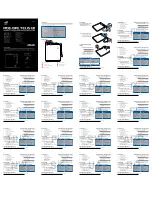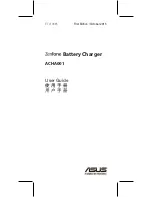
GB
- 13 -
Acid density values (kg/l at 20°C)
1.28
Battery charged
1.21
Battery semi-charged
1.16
Battery discharged
5.2 Finishing charging the battery
•
Pull the plug out of the socket.
•
First disconnect the black charging cable
from the bodywork.
•
Then release the red charging cable from the
positive pole on the battery.
•
Important!
In case of positive earthing, first
disconnect the red charging cable from the
bodywork and then the black charging cable
from the battery.
•
Screw or push the battery stoppers back into
position (if there are any).
6. Overload cut-out
Fig. 3:
The integral
fl
at fuse protects the equipment from
polarity reversal and short circuits. If the fuse
su
ff
ers a defect it must be replaced by a new fuse
with the same amp value. If you wish to replace
the
fl
at fuse,
fi
rst pull the mains plug out of the
socket and remove the charger clamps from the
battery. In the event of a thermal overload, an
automatic circuit breaker will stop the charging
process. After a cooling break it will cut in again
automatically.
7. Maintenance and care of the
battery
•
Ensure that your battery is always fitted se-
curely.
•
A perfect connection to the cable network of
the electrical system must be ensured at all
times.
•
Keep the battery clean and dry. Apply a thin
coating of grease to the connection terminals
using an acid-free, acid-resistant grease
(Vaseline).
•
Check the level of the acid in batteries that
are not maintenance-free versions approxi-
mately every 4 weeks and top up with distilled
water if necessary.
8. Cleaning, maintenance and
ordering of spare parts
Danger!
Always pull out the mains power plug before star-
ting any cleaning work.
8.1 Cleaning
•
Keep all safety devices, air vents and the
motor housing free of dirt and dust as far as
possible. Wipe the equipment with a clean
cloth or blow it with compressed air at low
pressure.
•
We recommend that you clean the device
immediately each time you have finished
using it.
•
Clean the equipment regularly with a moist
cloth and some soft soap. Do not use
cleaning agents or solvents; these could at-
tack the plastic parts of the equipment. Ensu-
re that no water can seep into the device. The
ingress of water into an electric tool increases
the risk of an electric shock.
•
The charger should be placed in a dry room
for storage. Any corrosion must be cleaned
off the charging terminals.
8.2 Maintenance
There are no parts inside the equipment which
require additional maintenance.
8.3 Ordering replacement parts:
Please quote the following data when ordering
replacement parts:
•
Type of machine
•
Article number of the machine
•
Identification number of the machine
•
Replacement part number of the part required
For our latest prices and information please go to
www.isc-gmbh.info
Anl_CC_BC_5_12_SPK1.indb 13
Anl_CC_BC_5_12_SPK1.indb 13
09.03.16 09:01
09.03.16 09:01














































